 Biometrics have continued the inevitable migration from the desktop device to the mobile device. Both the mobile industry and the biometric industry have continued to strive for smaller and more capable devices. The past few years have seen the accelerated adoption of biometrics on mobile devices. Most recently, iris biometrics have been added to Samsung devices as a logical extension to their current support of fingerprints.
Biometrics have continued the inevitable migration from the desktop device to the mobile device. Both the mobile industry and the biometric industry have continued to strive for smaller and more capable devices. The past few years have seen the accelerated adoption of biometrics on mobile devices. Most recently, iris biometrics have been added to Samsung devices as a logical extension to their current support of fingerprints.
Multiple biometric hardware devices have been introduced to the market, and with each generation the size and processing power has been increased. With the introduction of the Cross Match SEEK, SEEK Avenger, and Verifier Sentry, the footprint of these devices has been reduced. The new suite of Android processors and small, low power fingerprint devices has allowed for devices from Amrel, Credence, and Northrup Grumman to enter the market and compete directly with traditional Intel-based systems.
As has existed for many years in the desktop processing space, the ability to rapidly utilize new biometric and host technologies has been the key to success. With regards to desktop systems dominated by Microsoft Windows, the abstraction benefit is mostly with the accessory hardware devices. In this case the operating system and the host hardware are both standardized with MS Windows and primarily Intel CPUs migrating from one desktop system to another is rarely a significant effort. Migrating from one suite of biometric collection hardware to another suite, however, can result in significant engineering effort. Each new device must be integrated, new workflows required by the new device adapted to the existing application workflows, tested, deployed, and system operators trained on the new operations and requirements of the new hardware. The utilization of hardware abstraction software allows for the integration cycle to be dramatically shortened. With the use of fingerprint device abstraction software like Aware’s LiveScan API the engineering requirement required to change between two different livescan devices consists of the setting of a single configuration parameter. Often time’s re-compilation of the source code is not required.
Mobile computing introduces multiple variables to the need to have identical user experiences across devices. These variables include host computing platform, operating system, screen size and resolution (of minor concern), and biometric collection devices. Each of these variables provide their own unique challenges. The relevant host platforms include Windows/Intel, Android, and iOS. Here, the core processing is the most relevant to abstraction. This processing includes data analysis (e.g. biometric quality assessment, image compression) and data packaging (e.g. EBTS generation). Often OS native languages or high level languages are either not portable to other operating systems or are not optimized for the intense computation required by digital image processing systems. By utilizing SDKs written in low level languages (C, C++) the system gains portability and speed of processing. More importantly these tools can be re-compiled for multiple operating systems and therefore the system benefits from identical code being used across the mobile enterprise. Screen size and resolution is an issue that is commonly addressed by modern user interface centric programming languages that provide anchors and springs to allow application interfaces to adapt to varying display conditions thus easing the efforts required to make applications portable between hosts.
The final link in the host abstraction chain is the ability to rapidly support a variety of capture devices. As has become the key for successful Microsoft Windows based applications the ability to utilize the greatest number of biometric devices possible this will be the key to successful mobile applications. While many mobile devices include integrated biometric devices the need to support multiple devices on that single device is negligible. However truly successful development efforts will be targets writing applications that can be hosted on multiple devices. In this case the ability to quickly incorporate support for multiple devices allows for decreased development effort and increased support footprint.
During a recent contracted effort, Aware developed an application for a specific hardware suite. The core development utilized several tools for device abstraction. During the effort the host platform was end-of-life’d and would not be available for the production effort. This event effectively ended the contracted effort. Aware proposed an effort to test multiple systems that had recently come to market. Within thirty days, Aware fully vetted four separate systems and provided the customer with a detailed report from which to make their final selection and therefore resume the contracted effort with a minimal schedule slip. Had the hardware and software abstraction tools not been utilized the effort would have ended with the initial hardware device.
In summary, there are several design choices to be made during a system architecture and development effort. These include meeting the core requirements of the system and how to best visually represent the data and processes. The design decisions should also include elements beyond the immediate use of the system. How can the application be utilized across multiple hardware hosts? How can the customer benefit from not only supporting the current suite of biometric devices but devices with equivalent functionality, less expensive devices, or the next generation of devices that exceed the capabilities of the current devices at a decreased cost? What is the cost-benefit summary of an investment in a multi-platform suite of tools allow the developers to support multiple platforms with minimal effort. Through the use of software development toolkits focused on hardware abstraction the most can be made of an engineer’s effort and the corporate investment into a mobile biometric enrollment application.

